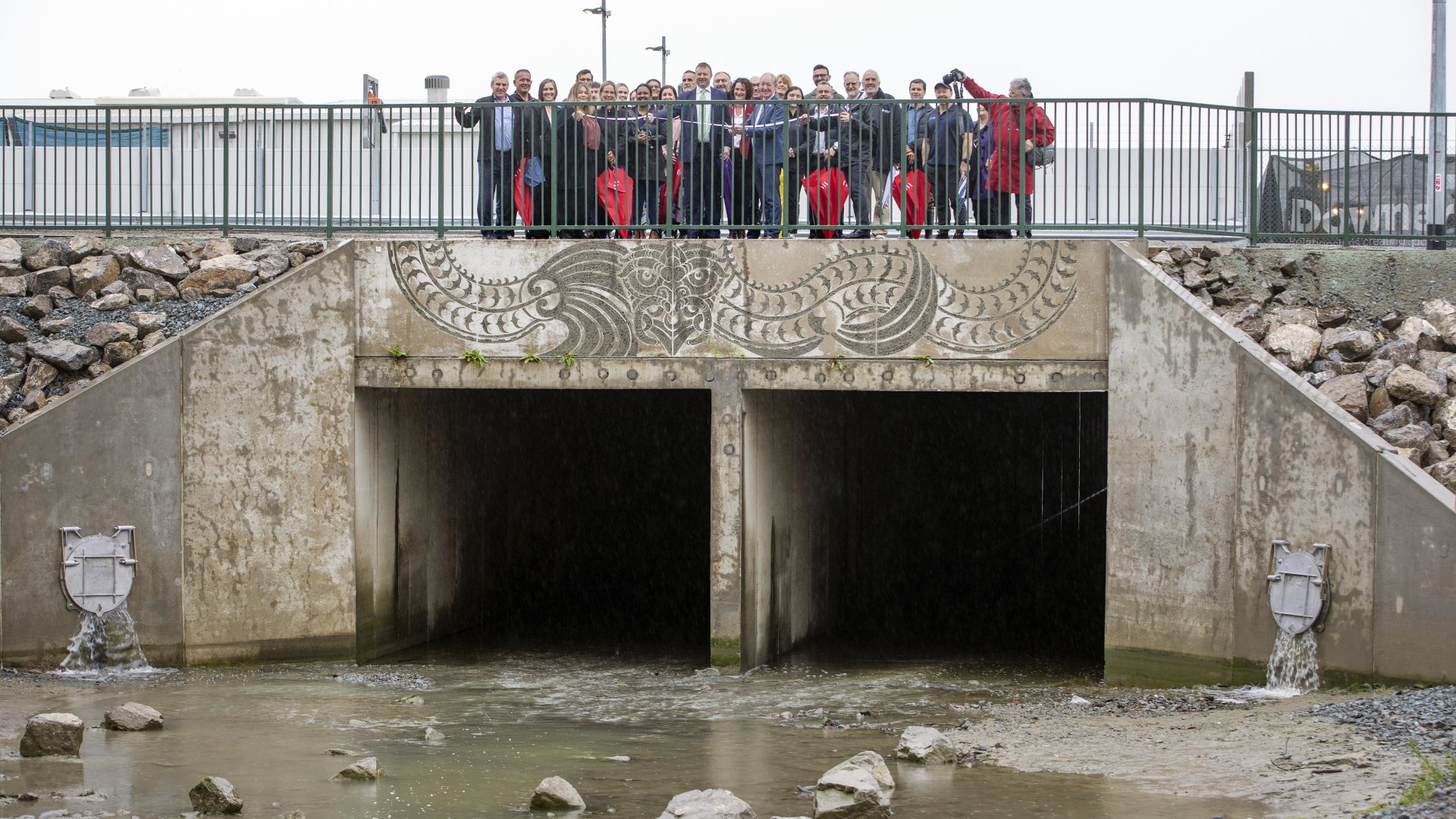Saxton Creek upgrade completed
18/04/2024 12:00pm
The $40 million, 2km-long Saxton Creek upgrade project, between Champion Road and State Highway 6, is now complete, increasing its ability to handle a 1-in-100-year flood event, up from a 1-in-5-year flood event.
“The completion of this $40 million upgrade of Saxton Creek hugely improves the resilience of this southern corner of Nelson City,” says Nelson Mayor Nick Smith.
“This major investment is well justified given the strategic importance of protecting the road link between Nelson and Richmond and the scale of commercial, residential and recreational development in the area.
“I know firsthand of the devastation to businesses and homes from previous flooding in this area, and heard the pleas for improved infrastructure. It has required a huge team effort of engineers, contractors, Council staff and adjacent property owners to get this extensive project completed.”
Extreme weather events in December 2011 and April 2013 caused significant flooding to both commercial and residential properties in the Saxton area.
Council policy pre-2011 was to upgrade its streams and rivers to cater for a 1 in 100-year flood event and the 2011 and 2013 events made the Saxton Creek upgrade a priority.
The project’s primary aim was to minimise damage to property in future weather events.
Split into four stages, with construction beginning in February 2016, the project team had to overcome several challenges including disruption to the work programme from the COVID-19 pandemic and severe weather events.
“This is one of the most complicated and complex projects that Council has been involved in,” says Group Manager Infrastructure Alec Louverdis.
“Challenges presented themselves before diggers were even on site and continued throughout. The creek travelled through residential areas with up-and-coming subdivisions, through reserves, across main roads, through industrial estates, compounded by the effects of some horrendous weather events, and a global pandemic thrown into the mix.”
While stream upgrades usually start downstream and progressively work upstream, the work was reversed to cater for the subdivisions at the upstream end and to dovetail with work Tasman District Council needed to do along Champion Road. These early stages were especially challenging as Council had to work with up to 40 individual residential landowners, which included ownership changes several times over the course of design work.
“Sometimes, we would be on the verge of concluding negotiations with a homeowner, and then we’d be required to start again from scratch,” says Louverdis.
Capital Projects Manager Rebecca Dawkins says this project, more than most, required dedicated oversight.
“Our project managers generally have five to eight projects on the go, but the Saxton Creek upgrade and stage 4 in particular, required a dedicated project manager. The requirements to liaise with businesses, residents and the community, apply for and maintain resource consents and monitor budgets was a huge piece of work internally. If you asked Council, we’d say this was the most complex part of the job for us, but for contractors, they’d say water,” she says.
What to do with all the water? The creek had to be redirected through pipes to ensure it could continue to flow, while allowing the contractors to work. There were also tidal fluctuations that required contractors to plan their work schedule around the daily tides. Installing fish passages allowed contractors to move a population of large eels.
“We needed to understand fish spawning seasons, fish habitats and behaviours,” says Dawkins.
“Fish require gravel along riverbeds and baffles in the culvert to rest in and plants along the riverbed to provide shade.”
Maintaining access through Main Road Stoke was another priority.
“We are keenly aware that there are only two routes between Nelson and Richmond; we knew the disruption closing Main Road Stoke would cause. Contractors needed to undertake the project without closing the road,” says Louverdis.
Over the eight construction years of the project, Nelson experienced more than its fair share of major weather events, predominately Cyclone Fehi and Gita in 2018, followed by the August 2022 weather event, and another major flood in May 2023. In the 2022 weather event, the amount of water passing through the diversion pipes was so considerable that the large concrete blocks anchoring the pipes shifted.
“Water drains away but it leaves a massive mess behind it. You have days of clean up before you can even consider continuing with the project,” says Dawkins.
“During the August 2022 weather event, the contractors and commercial property owners were on site all night trying to manage the flow of water and miminise the impact. The August and May weather events were real setbacks for this project.”
The project also required some unique solutions to unique engineering problems. The culvert under Main Road Stoke is made of 68 L-shaped blocks. Each block weighs 23 tonnes and had to be placed into the creek by a crane. Once the blocks were in the creek, an excavator would push them into place sliding them along Teflon rails.
The rock armouring along the creek in stages 1 – 3 used approximately 4,500 tonnes of rock and 3,000 tonnes of concrete for the pre-cast sections in the culvert along with a total of 112,000 contractor, consultant and Nelson City Council staff hours.
“This project created 27 jobs for Nelsonians, 20 of them in construction. We used five local subcontractors alongside the main contractor Downer,” says Dawkins.
Councillor Pete Rainey sat on Council in 2011 when the floods triggered the culvert upgrade and sits on Council today.
“The unbelievable severity of the floods and the dramatic impact on the surrounding area - especially for the businesses in the Wakatu estate really hit home for all the members of Council and staff at that time,” he says.
“The floods and the associated rain bomb were such localised events - and took us all by surprise really. It was hard to believe so much damage and mayhem could occur in such a localised area. I take my hat off to our infrastructure team at Council for the amazing work over all of the stages of the project and in particular to Alec Louverdis who has approached this huge multifaceted project with so much determination and professionalism. They, and Alec in particular, should feel very proud of the achievement in reaching this milestone.”
No project can ever ensure 100% certainty against weather events, but projects like this go a long way towards minimising the impact weather events have on communities.
“We’ve tried to improve the amenity of the area, too,” says Louverdis.
“There are some lovely boardwalks from Champion Road through Saxton Field and walking loops that we’ve built alongside the river.”
“All that’s left on the to-do list is some planting along the culvert. We’ve solved a problem with engineering, but we’ve also made the area more desirable for the community.”

